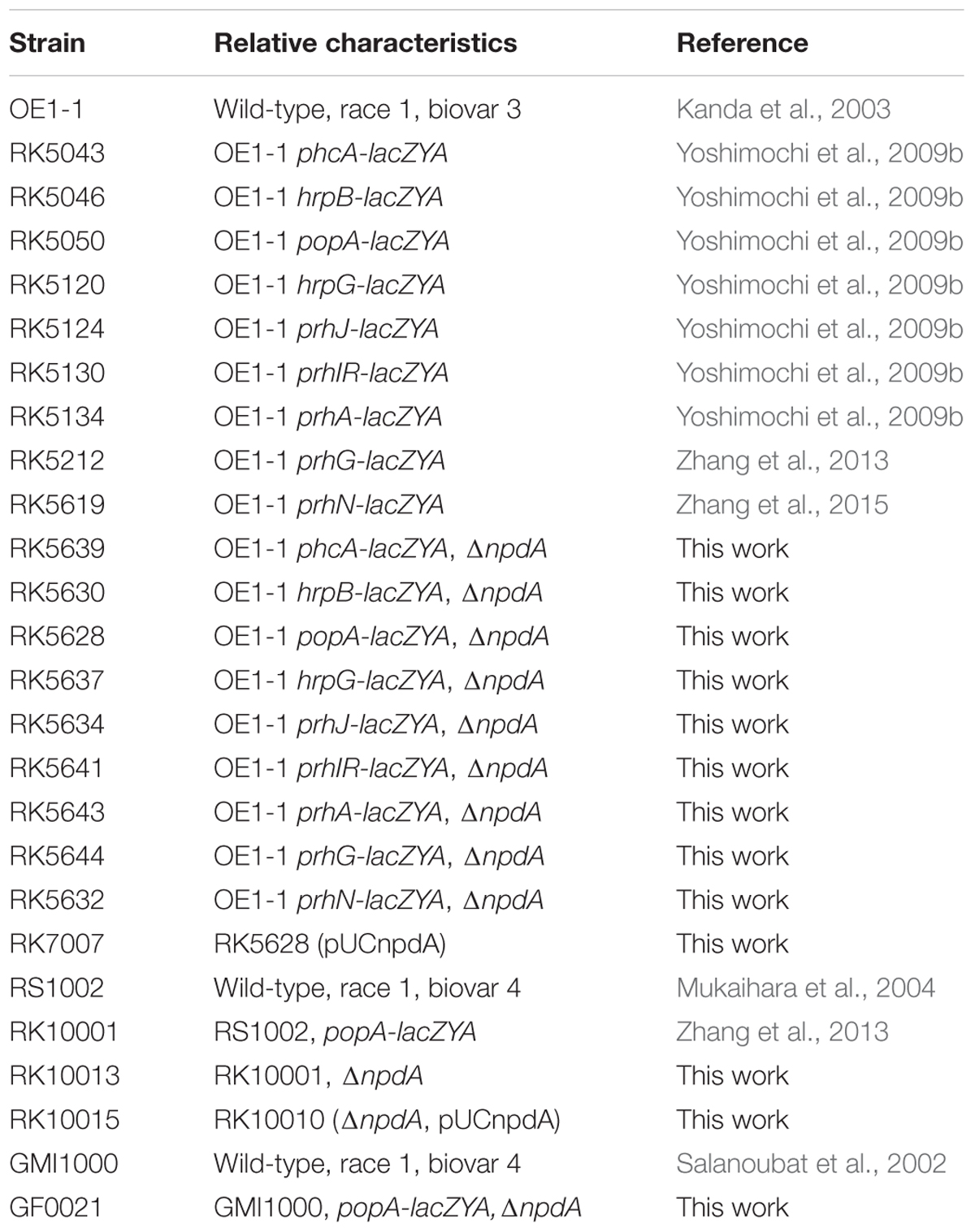- 1College of Resources and Environment, Southwest University, Chongqing, China
- 2The Ninth People’s Hospital of Chongqing, Chongqing, China
- 3Department of Pharmacognosy, College of Pharmacy, Third Military Medical University, Chongqing, China
- 4Research Institute of Molecular Genetics, Kochi University, Kochi, Japan
Previously, we isolated several genes that potentially affected the expression of type III secretion system (T3SS) in Ralstonia solanacearum OE1-1. Here, we focused on the rsp0316, which encodes a putative 2-nitropropane dioxygenase (hereafter designated NpdA). The deletion of npdA substantially reduced the T3SS expression and virulence in OE1-1, and the complementation with functional NpdA could completely restore its reduced T3SS expression and virulence to that of wild type. The NpdA was highly conserved among diverse R. solanacearum species and the NpdA-dependent expression of T3SS was not specific to OE1-1 strain, but not the virulence. The NpdA was important for the T3SS expression in planta, while it was not required for the bacterial growth in planta. Moreover, the NpdA was not required for the elicitation of hypersensitive response (HR) of R. solanacearum strains in tobacco leaves. The T3SS in R. solanacearum is directly controlled by the AraC-type transcriptional regulator HrpB and regulated by a complex regulation network. The NpdA affected the T3SS expression mediated with HrpB but through some novel pathway. All these results from genetic studies demonstrate that NpdA is a novel factor for the T3SS expression in diverse R. solanacearum species in medium, but specifically for the T3SS expression in strain OE1-1 in planta. And the NpdA-dependent expression of T3SS in planta plays an important role in pathogenicity of R. solanacearum OE1-1 in host plants.
Introduction
The syringe-like type III secretion system (T3SS) is conserved in many bacterial pathogens of animals, plants, and insects and plays central roles in their pathogenicity (Hueck, 1998; Galán and Wolf-Watz, 2006). The bacteria use the T3SS to interact with host cells and inject virulence factors, so-called type III effectors (T3Es), into the host cytosol to subvert host functions (Angot et al., 2006; Jones and Dangl, 2006). In some bacterial plant pathogens, including the Ralstonia solanacearum, the T3SS is encoded by hypersensitive response and pathogenicity (hrp) genes, which are approximately 20 genes clustered together into a regulon (Arlat et al., 1992; Van Gijsegem et al., 1995). R. solanacearum is a soil-born Gram-negative vascular bacterium and can devastate more than 200 plant species worldwide (Genin, 2010). This results in the serious loss in many economically important plants every year, and until recently, there has been no general effective control for this bacterial wilt disease.
The T3SS in R. solanacearum is not constitutively expressed under any conditions. Its expression is not activated until the bacteria have contact with host signals (Aldon et al., 2000). The T3SS is not expressed under nutrient-rich conditions, but it is activated under nutrient-poor conditions, which might mimic the conditions of intercellular spaces in host cells. Moreover, when the bacteria directly contact host plants, the expression of the T3SS was induced to a 10- to 20-fold higher level than that under nutrient-poor conditions (Marenda et al., 1998; Mukaihara et al., 2004; Yoshimochi et al., 2009b; Zhang et al., 2011). R. solanacearum has a large repertoire of T3Es (averaged more than 70 T3Es per strain), and most of them play important roles in the interaction between R. solanacearum and host cells (Coll and Valls, 2013; Peeters et al., 2013). The T3SS and entire T3Es are directly controlled by the master regulator HrpB, which is an AraC family transcriptional regulator and is essential for the pathogenicity of R. solanacearum (Arlat et al., 1992; Genin et al., 1992; Vasse et al., 2000; Mukaihara et al., 2004, 2010). The expression of hrpB is triggered by plant signals or other related signals. These signals are recognized and transferred to HrpB through the complex signaling cascade PrhA–PrhR/I–PrhJ-HrpG or some unknown pathway (Brito et al., 2002; Cunnac et al., 2004; Valls et al., 2006). Moreover, the expression of hrpB is positively regulated in a parallel way by both HrpG and prhG, which are close paralogs and response regulators of the OmpR/PhoB family of two-component system (Plener et al., 2010; Zhang et al., 2013). However, the quorum sensing-dependent regulator PhcA regulates the expression of hrpG and prhG in an opposite ways. PhcA negatively regulates hrpG expression indirectly (Yoshimochi et al., 2009a) but positively regulates prhG expression (Zhang et al., 2013). R. solanacearum might dynamically activate hrpB expression through HrpG and PrhG in a cell density-dependent manner (Zhang et al., 2013). Generally, R. solanacearum uses a complex regulation network to globally regulate the expression of the T3SS and promote disease development in host plants, but this network needs to be further elucidated (Valls et al., 2006; Hikichi et al., 2007).
In our study, the T3SS expression in OE1-1 was monitored with a popA-lacZYA fusion, which combining the promoter of popA to promoterless lacZYA (a schematic is available as Supplementary Figure S1 in Zhang et al., 2013) and it exhibited almost identical expression profiles to that of T3SS under different conditions. Moreover, the generation of popA-lacZYA did not affect the bacterial growth and virulence of OE1-1 in host plants. Here, we focused on a novel candidate, Rsp0316 (prh24 in Zhang et al., 2013), which was isolated from the Japanese R. solanacearum strain OE1-1 with transposon mutagenesis (Zhang et al., 2013). The popA expression in this Tn5 mutant was substantially reduced, suggesting that the Rsp0316 might be a positive effector for the T3SS expression in R. solanacearum and hence related to its virulence. Rsp0316 encodes a putative 2-nitropropane dioxygenase (NPD) and is highly conserved in all Ralstonia species and other bacteria (hereafter designated NpdA). NPDs are known to participate in nitrogen metabolism, but the involvement of NPDs in the virulence of pathogens has rarely been investigated (Gorlatova et al., 1998; Francis et al., 2005). Here, we characterized the impact of NpdA on the T3SS expression and the virulence of R. solanacearum in host plants and demonstrate that the NpdA is required for the T3SS expression in diverse R. solanacearum species in medium but specifically for the T3SS expression in planta and full virulence of R. solanacearum OE1-1 in host plants.
Materials and Methods
Bacterial Strains and Culture Conditions
Ralstonia solanacearum strains used in this study were listed in Table 1. OE1-1 strain (phylotype I, race 1, biovar 3) is virulent in tomato and tobacco plants (Kanda et al., 2003). RS1002 (Mukaihara et al., 2004) and GMI1000 (Salanoubat et al., 2002) strain (phylotype I, race 1, biovar 4) are virulent in tomato plants but elicit hypersensitive response (HR) in tobacco leaves. R. solanacearum was grown at 28°C in rich B medium or in hrp-inducing medium (hydroponic plant culture medium containing 2% sucrose) (Yoshimochi et al., 2009b). Escherichia coli DH12S and S17-1 (Simon et al., 1983) were grown in Luria-Bertani (LB) medium at 37°C and used for plasmid construction and conjugational transfer, respectively. Antibiotics were added into the media at the following concentrations: ampicillin (Ap), 100 μg ml-1; gentamicin (Gm), 20 μg ml-1; kanamycin (Km), 50 μg ml-1; polymyxin B (PB), 50 μg ml-1.
Construction of npdA in-Frame Deletion Mutants
In this study, the npdA in-frame deletion mutants were generated by pK18mobsacB- based homolog recombination as previously described (Zhang et al., 2015). Primer pairs 0316A1B (CATGGATCCATCAACCGTTCGAAGGAGA) with 0316B1C (TCAACGGAGACTTGTGCCCCACCCGTTGCATCCGCG) and 0316A2C (CGCGGATGCAACGGGTGGGGCACAAGTCTCCGTTGA) with 0316B2H (CATAAGCTTCCATCTGGACCTTCAGGT) were used for plasmid pK18dnpdA construction with the OE1-1 genomic DNA as PCR template. After validating the sequence, pK18dnpdA was transferred from E. coli S17-1 into the corresponding R. solanacearum strains, and npdA mutants were generated (listed in Table 1).
Complementation Analysis
The complementation was performed by using the pUC18-mini-Tn7T-Gm-mediated site-specific chromosome integration system (Choi et al., 2005) with some modification (Zhang et al., 2015). Primers pairs 0316A1B and 0316B3H (CATAAGCTTCAGGCCGTCGTCGCCGAAG) were used for the pUCnpdA construction with the OE1-1 genomic DNA as the template, which contained an approximately 500 bp-upstream region of npdA and empirically harbored its native promoter. The complemented npdA was specifically integrated into R. solanacearum chromosome at a single attTn7 site (25-bp downstream of the glmS gene) and was confirmed by colony PCR.
β-Galactosidase Assay
The gene expression level was evaluated by a lacZYA fusion-based β-galactosidase assay, and the assay (both in vitro and in planta) was performed as previously described (Zhang et al., 2013). Each assay was repeated for at least three independent experiments, and the averages with their respective standard deviation (SD) were determined. The statistical significance was assessed using the two-tailed Student’s t-test.
qRT-PCR Analysis
Total RNA was isolated from the hrp-inducing medium cultured R. solanacearum cells using the TRIzol reagent according to the manufacturer’s instruction (Life, United States). After validating the RNA quality, cDNA was synthesized using the PrimeScriptTM RT Reagent Kit with gDNA Eraser (Perfect for Real Time, TAKARA, Japan). The One Step SYBR® PrimeScriptTM PLUS RT-PCR Kit (TAKARA, Japan) was used for the qRT-PCR reactions with an Applied Biosystems 7500 Real-Time PCR System (Life, United States) to quantify the cDNA level. In this study, RipB, RipD, RipE, RipO, RipR, RipTAL, and RipW were selected for mRNA quantification by qRT-PCR and the serC gene was selected for reference (Monteiro et al., 2012). The primers used in this study were used as previously described (Wu et al., 2015). The experiments were repeated from RNA isolation for at least three independent replicates, and each treatment included four replications. The mean values were averaged with the standard deviation (SD), and statistical significance was determined using the two-tailed Student’s t-test.
Virulence Assay and HR Test
The virulence assay and HR test were performed as described previously (Yao and Allen, 2007) with some modifications (Zhang et al., 2013). Wilt-susceptible tomato plants (Solanum lycopersicum cv. Moneymaker) and tobacco plants (Nicotiana tabacum CV. Bright Yellow) were used for the virulence test by soil soak (with bacteria at a final concentration of 107 cfu g-1 of soil) and petiole inoculation (dropped 2 μl of bacteria at 107 cfu ml-1 onto the fresh-cut surface of petioles). Each experiment included at least 10 plants per treatment, and each assay was repeated at least in triplicate. Mean values were manipulated with standard deviation (SD), and their statistical significance was determined using the two-tailed Student’s t-test. N. tabacum BY was used for the HR test with leaf infiltration, and the symptom development of HR was recorded periodically. Each experiment was repeated for at least three independent replicates, and a representative result was presented.
Bacterial Growth in Planta
Bacterial growth in planta was performed as described previously (Zhang et al., 2013). Two to 3-week-old tomato plants were inoculated with bacteria using petiole inoculation, and the stem tissues (5 cm above the soil and 1 cm in length) were removed at 4 dpi (wilt symptoms reached to 1–2) and 7 dpi (wilt symptoms reached to 3–4). The cells were collected from the plant stem tissues and quantified by dilution plating. Each experiment was repeated for at least three independent replicates, and the mean values and SD values were determined. The statistical significance was assessed using the two-tailed Student’s t-test.
Results
NpdA Is Important for the popA Expression in R. solanacearum in Vitro
The T3SS expression in OE1-1 was monitored with a popA-lacZYA fusion in our study. The popA expression in npdA transposon mutant was reduced to approximately 30% of that in the wild-type strain, suggesting that NpdA might be required for the T3SS expression in R. solanacearum OE1-1 (Zhang et al., 2013). To confirm this phenomenon, we created the npdA in-frame deletion mutant RK5628 (popA-lacZYA,ΔnpdA) in OE1-1 strain and evaluated its popA expression level. First, no differences in the bacterial morphology and growth profiles were observed between the npdA mutants and wild-type strain in rich or hrp-inducing media (data not shown). Similar to that of the wild-type strain in rich medium, RK5628 did not express popA. However, in hrp-inducing medium, the popA expression in RK5628 was substantially reduced (an average of 74 vs. 313 Miller Units) (Figure 1). Additionally, the complemented npdA gene (integrated into the chromosome downstream of the glmS gene) could completely restore its popA expression to that of wild type in hrp-inducing medium (Figure 1), confirming that NpdA is an important factor for popA expression in R. solanacearum OE1-1. The strain RS1002 and GMI1000 exhibit distinctly different phenotype from OE1-1, and hence we generated the npdA deletion mutants from RS1002 and GMI1000. The popA expression was also substantially reduced in RS10013 (npdA deletion from RS1002) (Figure 1) and GF0021 (npdA deletion from GMI1000) (data not shown).
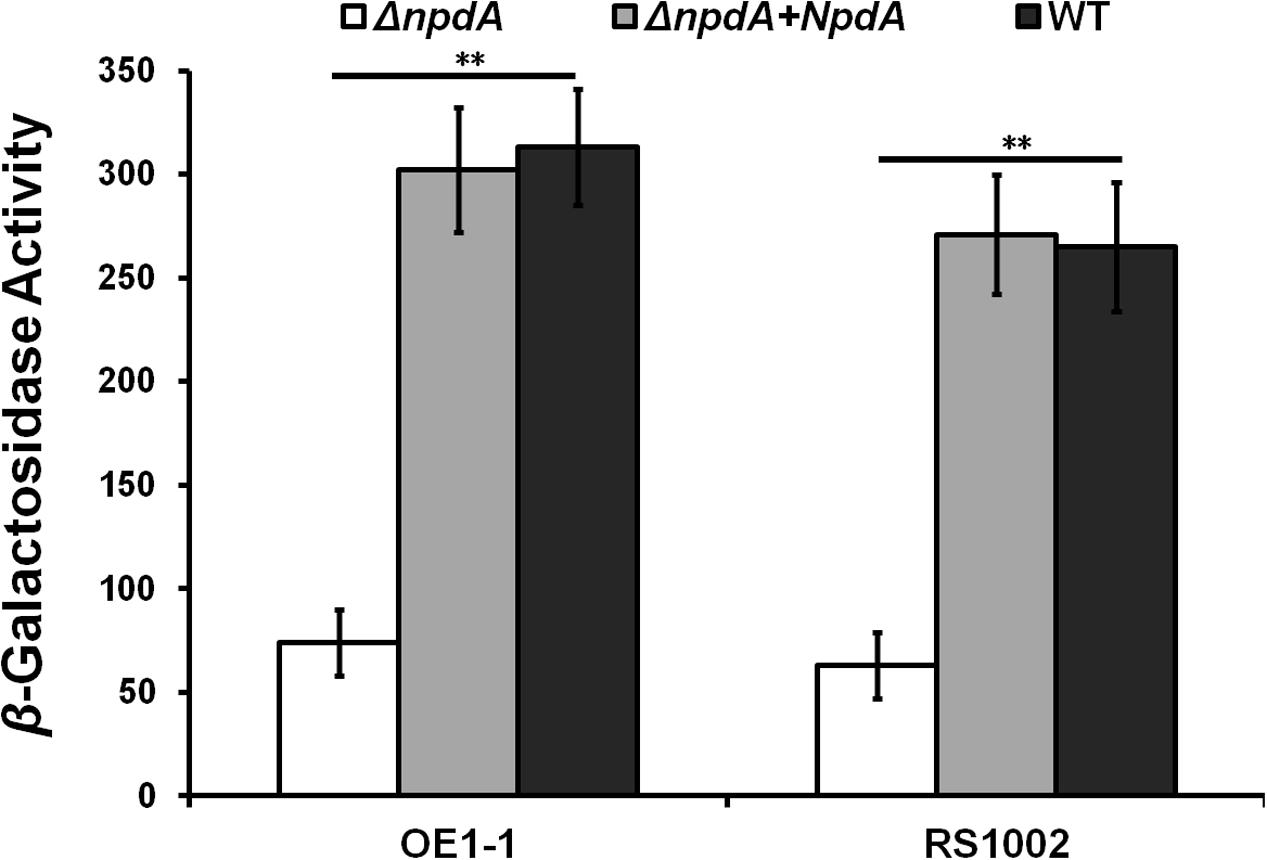
FIGURE 1. The popA expression in Ralstonia solanacearum strains. Left, OE1-1 derivatives; right, RS1002 derivatives. Black column, wild type; white column, the npdA deletion mutants; gray column, complementation with OE1-1 NpdA. Cells were grown in hrp-inducing medium to an OD600 of approximately 0.1 and subjected for β-galactosidase assay. The mean values of atleast 3 independent trials are presented in Miller units with SD (error bars). Significance level, ∗∗P < 0.01 (t-test).
NpdA is highly conserved in R. solanacearum species, and through NCBI blast, the identities of NpdAs amino acids between 28 R. solanacearum strains are greater than 93%. For instance, there is only one residue different from the total 335 amino acids of NpdAs between OE1-1 and GMI1000. Furthermore, the npdA gene of OE1-1 could fully complement the popA expression in RS10013 to that of the wild-type strain (Figure 1), suggesting that the NpdA-dependent expression of popA is highly conserved in R. solanacearum species.
NpdA Is Important for the Expression of Some T3Es in R. solanacearum in Vitro
The popA gene exists as part of an operon with popB and popC, and belongs to T3Es. Since NpdA is important for the popA expression, we further investigated whether it was required for the expression of some other T3Es in OE1-1. In this study, RipB, RipD, RipE, RipO, RipR, RipTAL, and RipW were selected for mRNA quantification by qRT-PCR. Among these T3Es, the mRNA levels of RipB, RipD, RipE, and RipR in hrp-inducing medium were significantly reduced in RK5628 (p < 0.01), and the mRNA level of RipW was also distinctly reduced (Figure 2), (p < 0.05). However, the npdA deletion did not change the mRNA levels of RipO and RipTAL, suggesting that the NpdA is also important for the expression of a subset of T3Es in R. solanacearum OE1-1.
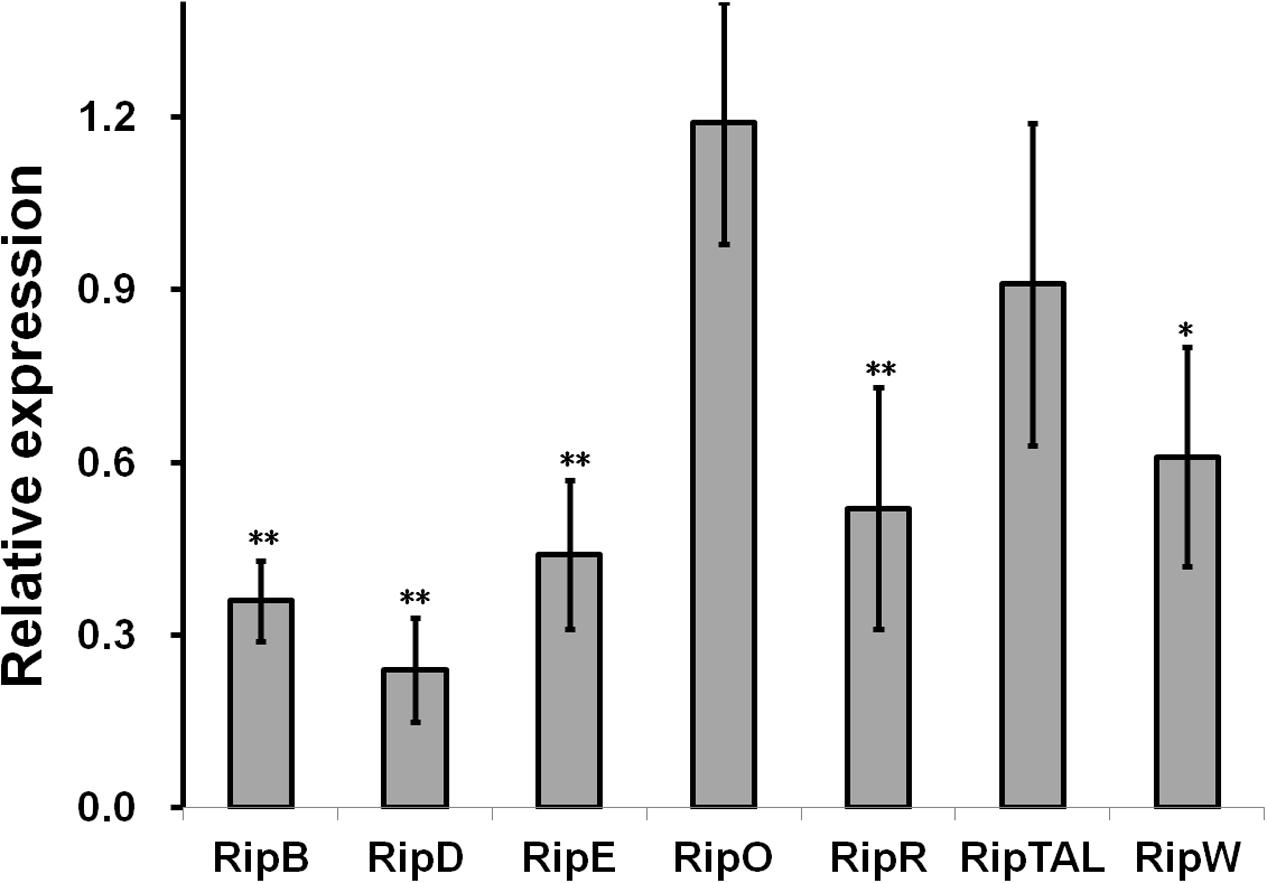
FIGURE 2. Relative expression of some T3Es genes in R. solanacearum OE1-1. Relative expression level of eight representative T3Es genes in hrp-inducing medium were determined by qRT-PCR and serC gene was used as reference gene. Normalized value was divided with that of wild type and relative values were presented. Each test was repeated in at least three independent trials and each trials included four replications. Mean values were averaged and presented with SD (error bars). Significance level, ∗P < 0.01, ∗∗P < 0.01 (t-test).
NpdA Is Particularly Required for the Full Virulence of R. solanacearum OE1-1
The T3SS and some T3Es are important for the pathogenicity of R. solanacearum in host plants. Thus, we evaluated whether NpdA was required for the virulence of R. solanacearum. When tomato plants were challenged with soil-soak and petiole inoculation, RK5628 could wilt and kill most of the test plants, while approximately 25% of the test plants did not die even up to 18 dpi (days post inoculation). For example, 22 of the 96 total soil-soak inoculated tomato plants began to wilt at 8–10 dpi, but the wilt symptoms remained up to 18 dpi; then, the disease index of RK5628 was found to be approximately 3 at 12–18 dpi (Figure 3A). When tomato plants were challenged with petiole-inoculation, the virulence of RK5628 was also significantly reduced (Figure 3B). RK5628 exhibited significantly lower virulence than that of OE1-1 strain in tomato plants. With complementation, the npdA gene could completely restore its less virulence to that of wild type (Figures 3A,B), confirming that NpdA is important for the full virulence of R. solanacearum OE1-1 in tomato plants.
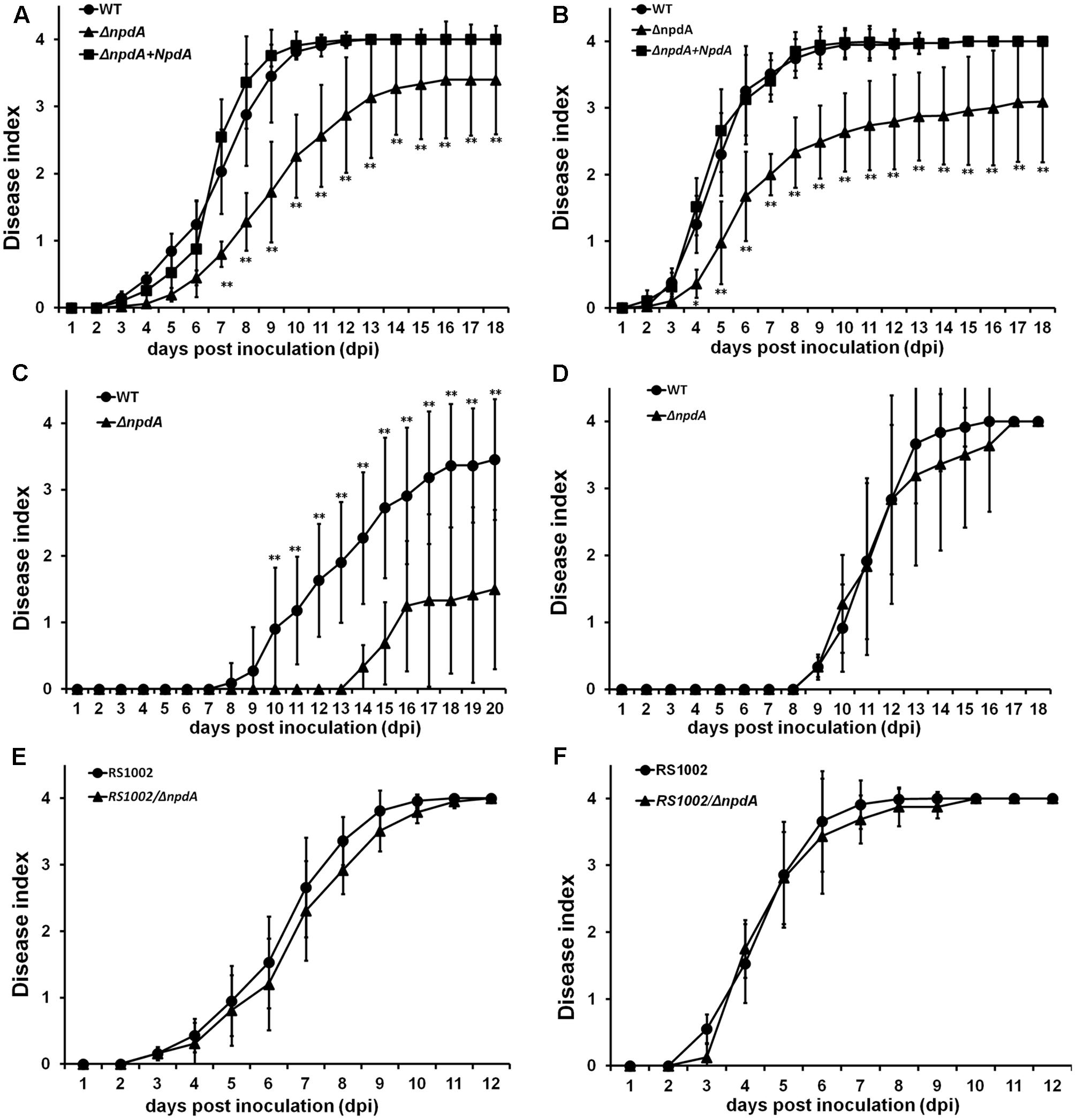
FIGURE 3. Pathogenicity test. R. solanacearum strains, (A–D) OE1-1 derivatives; (E,F) RS1002 derivatives. Inoculation methods: (A,C,E) soil soak inoculation, a bacterial suspension was poured into the soil of plants at a final concentration of 107 cfu g-1 of soil; (B,F) petiole inoculation, about 3 μl of bacterial suspension at 108 cfu ml-1 was dropped onto freshly cut surface of petioles; (D) Leaf infiltration in tobacco leaves, about 50 μl of bacterial suspension at 108 cfu ml-1 was infiltrated into tobacco leaves with a blunt-end syringe. Plants, (A,B,E,F) tomato plants; (C,D) tobacco plants. Closed circle, wild type; closed triangle, npdA mutant; closed square, complementation with OE1-1 NpdA. Plants were inspected daily for wilt symptoms, and scored on a disease index scale from 0 to 4 (0, no wilting; 1, 1–25% wilting; 2, 26–50% wilting; 3, 51–75% wilting; and 4, 76–100% wilted or dead). Each assay was repeated in four independent trials (each trial contains at least 10 plants) and mean values were averaged and presented with SD (error bars). Significance level, ∗P < 0.01, ∗∗P < 0.01 (t-test).
Ralstonia solanacearum OE1-1 is also virulent in tobacco plants. Thus, we evaluated whether NpdA was required for the virulence of OE1-1 in tobacco plants. When tobacco plants were challenged with soil-soak inoculation, significantly reduced virulence by RK5628 was also observed (Figure 3C). When the bacteria were directly inoculated into tobacco plants with leaf infiltration, no difference in virulence was observed between the RK5628 and OE1-1 (Figures 3D).
The RS1002 strain is virulent in tomato but elicits HR in tobacco leaves. We also tested the virulence of RS10013 (npdA deletion in RS1002 strain) in tomato plants using both the soil-soak and petiole inoculation methods, respectively. It was very intriguing to find that this npdA mutant exhibited almost identical virulence as that of the wild-type RS1002 strain (Figures 3E,F), suggesting that NpdA was not involved in virulence of RS1002 in host plants. The involvement of NpdA in virulence of R. solanacearum is specific to OE1-1 in host plants.
NpdA Is Not Involved in the HR Elicitation of R. solanacearum
Some T3Es are responsible for the HR elicitation in resistant plants. Thus, we evaluated whether NpdA is involved in the HR elicitation of RS1002 and GMI1000 in tobacco leaves. When infiltrated into tobacco leaves (N. tabacum BY), RS10013 (npdA deletion in RS1002 strain) caused apparent necrotic lesions at 16 hpi (hours post inoculation), and the area of necrotic lesions reached a maximum at 24 hpi (Figure 4). The npdA mutant in RS1002 caused almost the same development of necrotic lesions as RS1002 in tobacco leaves (Figure 4). Moreover, GF0021 (npdA deletion in GMI1000 strain) caused identical development of necrotic lesions as GMI1000 in tobacco leaves (data not shown), suggesting that NpdA was not involved in the HR elicitation of R. solanacearum strains in tobacco leaves.
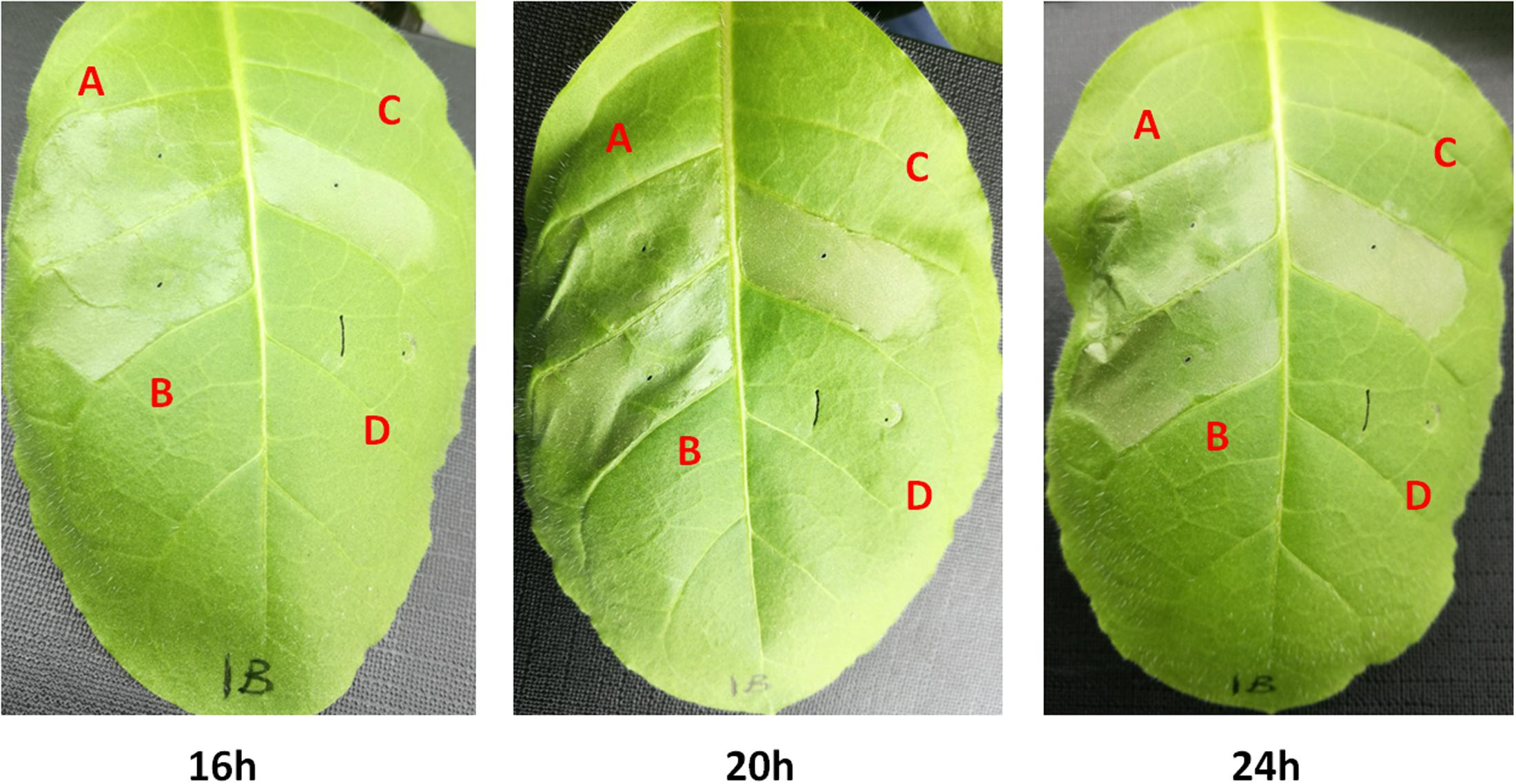
FIGURE 4. HR test. Approximate 50 μl of bacterial suspension at 108 cfu ml-1 was infiltrated into the leaf mesophyll tissue with a blunt-end syringe. (A) RS1002; (B) npdA mutant (RK10013); (C) RK10015 (complementation with OE1-1 NpdA); (D) distilled water. Development of necrotic lesions was observed periodically and pictures were taken. Each experiment were repeated in triple and each treatment contains four plants. The results presented are from a representative experiment, and similar results were obtained in all other independent experiments.
NpdA Is Not Required for the Growth of R. solanacearum in Planta
As a vascular pathogen, the growth capacity of R. solanacearum in host plants is essential for its virulence. Therefore, we evaluated whether NpdA was required for the growth of R. solanacearum in planta. We inoculated tomato plants with RK5628 using petiole inoculation and quantified the number of cells in stem tissues with dilution plating. RK5628 proliferated in the stem to approximately 108 cfu g-1 at 4 dpi and approximately 1010 cfu g-1 at 7 dpi (Figure 5). RK5628 exhibited almost the same bacterial growth as that of OE1-1 in tomato stem, suggesting that NpdA was not required for the bacterial growth of R. solanacearum in planta.
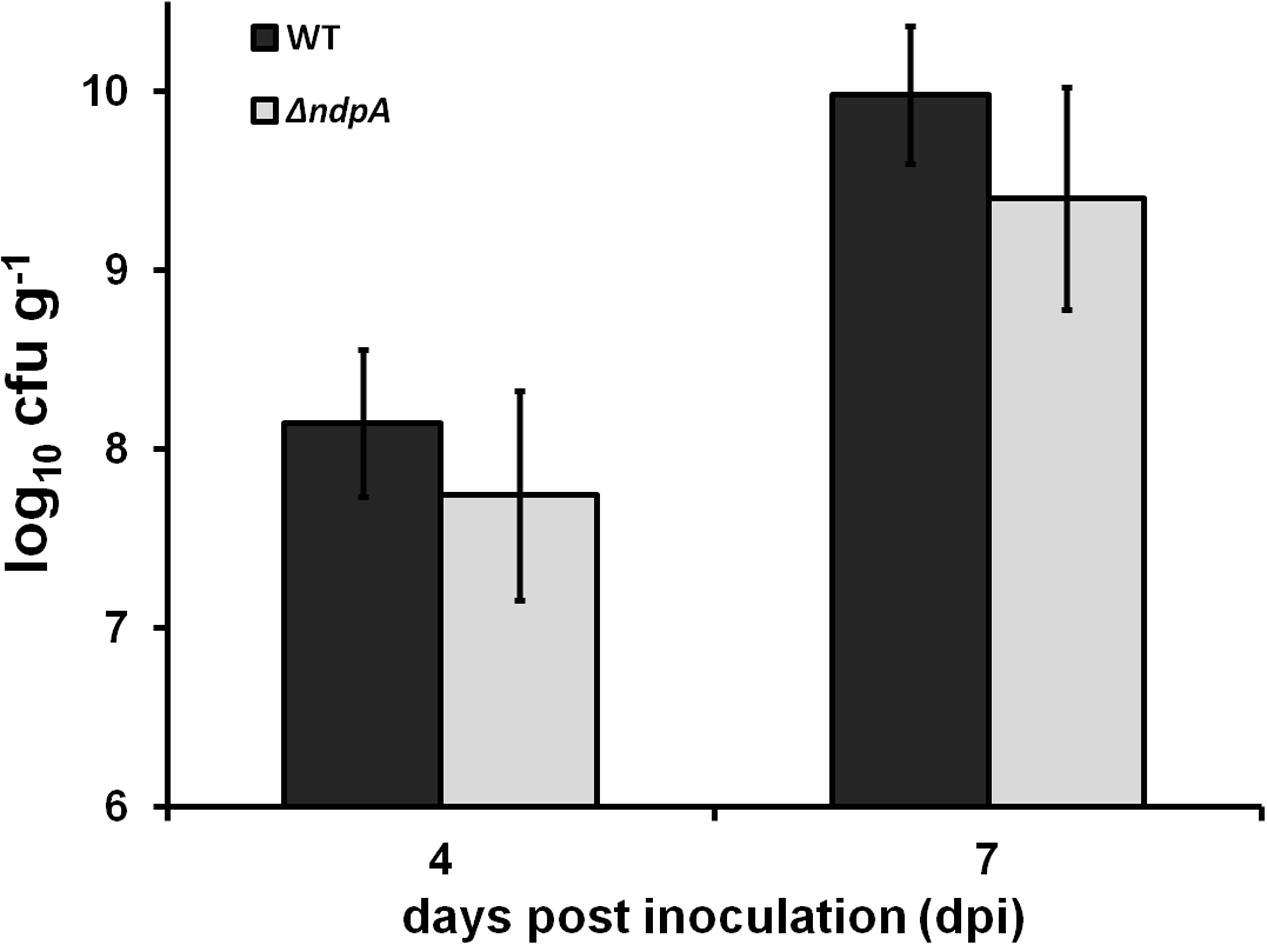
FIGURE 5. Bacterial growth test in planta. Tomato plants were inoculated with bacteria using petiole inoculation and stem species were removed at 4 and 7 dpi. Cells number was quantified by dilution plating. Black column, wild type (RK5050); gray column, npdA mutant (RK5628). Each experiment was repeated in triple and each treatment contains four plants. Mean values were averaged and presented with SD (error bars).
NpdA Is Important for the popA Expression in Planta But Only in OE1-1 Strain
The expression level of T3SS in planta could be induced to a much-higher level than that in the hrp-inducing medium. Thus, we further investigated whether NpdA was involved in the induction of T3SS expression in host plants. We challenged tomato plants with petiole-inoculation and collected the bacterial cells from the stems for the β-galactosidase assay in planta (normalized by cells number). The popA expression in the RK5050 (derivatives of OE1-1) increased at 3, 4, and 5 dpi and then decreased quickly to a much lower level at 6 dpi (Zhang et al., 2013). We detected their expression daily from 3 dpi (the wilt symptom appeared) to 6 dpi (wilt symptom increased to 3–4). Similar to that of wild type, the popA expression of RK5628 (derivatives of OE1-1) in tomato stems increased from 3 dpi, reached a maximum at 5 dpi, and then quickly decreased at 6 dpi (Figure 6A). It was distinctly less than that of the wild-type strain in tomato stems at 3 dpi (p < 0.05) and significantly less than that of the wild-type strain at 4–5 dpi (p < 0.01), suggesting that NpdA is also important for the popA expression of R. solanacearum OE1-1 in tomato plants. Although RK10013 (derivatives of RS1002) exhibited identical virulence to wild type RS1002, we also evaluated the popA expression in RK10013 in tomato stems. It was intriguing that RK10013 exhibited almost identical popA expression in tomato stems to that of wild type RS1002 (Figure 6B), indicating that the NpdA was not required for the popA expression of R. solanacearum RS1002 in tomato stems. All these suggested that the NpdA-dependent popA expression in planta was specific to OE1-1 strain.
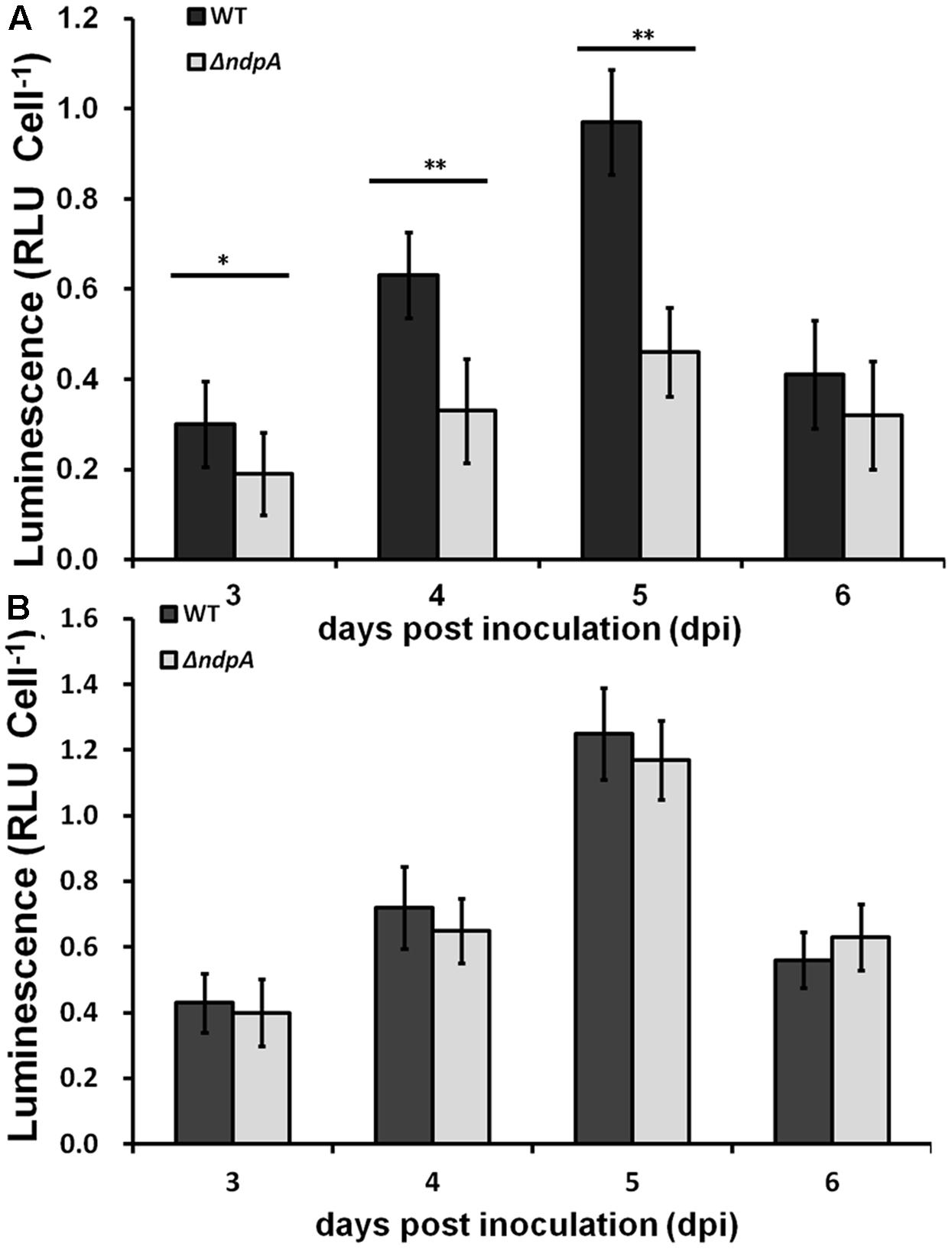
FIGURE 6. The popA expression in planta. (A) OE1-1 derivatives; (B) RS1002 derivatives. Black column, wild type strains; gray column, npdA mutants. Tomato plants were inoculated with bacteria using petiole inoculation and stem pecies were removed at 3–6 dpi for β-galactosidase assay in planta with Galacto-Light Plus kit and cells numbers were quantified by dilution plating. Each experiment was repeated at least in triple and each treatment contains four plants. Mean values were averaged and presented with SD (error bars). Significance level, ∗P < 0.01, ∗∗P < 0.01 (t-test).
NpdA Affected the T3SS Expression Through HrpB But Was Independent of Other Regulators
Ralstonia solanacearum uses HrpB to directly control the expression of the entire T3SS and T3Es, and the hrpB expression is regulated by a complex regulation network. We therefore investigated whether NpdA affected the T3SS expression through some known pathway. We generated some npdA deletion mutants from OE1-1 derivatives (Table 1) and evaluated its effect on the expression of these known regulators, including the prhA, prhIR, prhJ, hrpG, prhG, hrpB, phcA, and prhN genes. The deletion of npdA substantially reduced the hrpB expression in hrp-inducing medium (43 vs. 175 miller units), while it did not change the expression of other regulators, either in hrp-inducing medium (Figure 7) or rich medium (data not shown), suggesting that NpdA affected the T3SS expression through HrpB and its influence was independent of these known regulators.
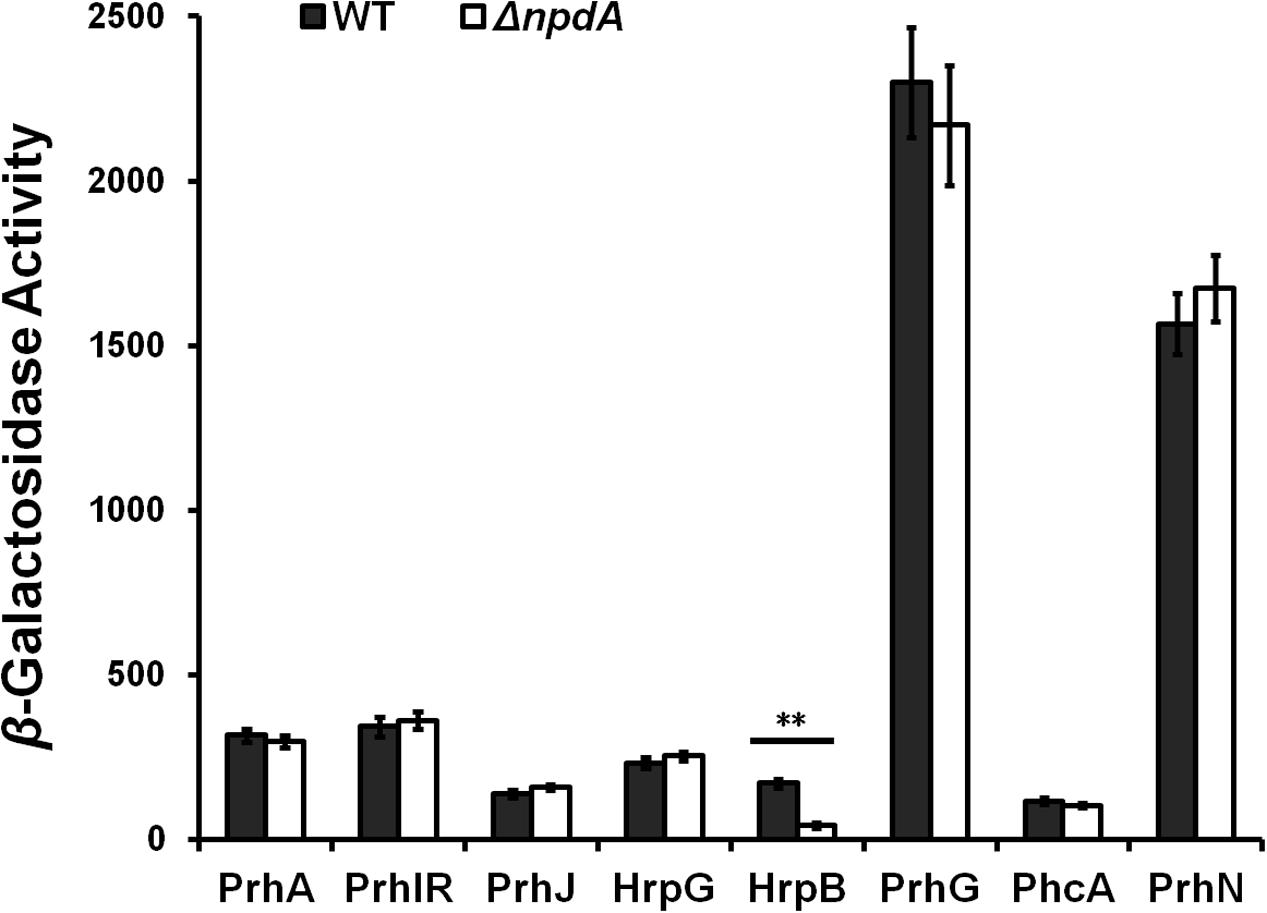
FIGURE 7. Expression of some known regulators in R. solanacearum. Black column, wild type (RK5050); gray column, npdA mutant (RK5628). Cells were grown in hrp-inducing medium to an OD600 of approximately 0.1 and subjected for β-galactosidase assay in vitro. Mean values were averaged and presented with SD (error bars). Significance level, ∗∗P < 0.01 (t-test).
Discussion
In the present study, we demonstrated that R. solanacearum NpdA was involved in the infection process of OE1-1 in host plants. NPDs exist extensively in many microorganisms and plants. In plants, NPDs are reported to be defense or stress-related enzymes. For example, npdA is significantly upregulated in hypocotyl tissues once the cotton seedling is infected with Fusarium oxysporum f. sp. vasinfectum (Dowd et al., 2004). NPDs are a type of oxidoreductases, which catalyze 2-nitropropane into nitrite and acetone, and participate in nitrogen metabolism (Kido et al., 1976; Francis et al., 2005). Moreover, they exhibit potential abilities in detoxification and bioremediation since they can also degrade nitroalkanes and some nitro-aromatics, which are usually toxic to microorganisms or harmful to the environment, into nitrate and nitrite (Nishino et al., 2010). Plants produce many organic compounds, and hence, their interacting bacteria should have evolved traits to degrade these metabolites. Comparative genome analysis revealed that a plant-associated bacterial endophyte Burkholderia phytofirmans PsJN evolved a high number of ring cleavage enzymes, including the 2-nitropropane dioxygenase, to degrade plant-produced organic compounds (Mitter et al., 2013). The genome analysis also reveales that SAR86, an abundant but uncultivated marine bacterial lineage, harbors 7 nitropropane dioxygenases for antibiotic resistance (Dupont et al., 2012). However, up to date, there are barely reports that show that NPD is related to the pathogenicity of some pathogens.
T3SS plays an essential role in R. solanacearum virulence, and in this study, NpdA was demonstrated to be important for T3SS expression in R. solanacearum. NpdA is highly conserved in Ralstonia species and other bacteria, and NpdA of OE1-1 could indeed act on the popA expression in RS1002 strain and could completely substitute that of RS1002 in hrp-inducing medium. The NpdA-dependent expression of T3SS expression in hrp-inducing medium is universal in R. solanacearum species. R. solanacearum generally invades host plants from the root, multiplies rapidly in the root cortex, and then finally enters into xylem vessels (Roberts et al., 1988; Vasse et al., 1995). However, the deletion of npdA in RS1002 strain did not change its virulence in tomato plants, suggesting that the NpdA was specifically required for the virulence of R. solanacearum OE1-1 in host tomato plants.
As a vascular plant pathogen, the extensive proliferation in the host xylem and abundant production of extracellular polysaccharides (EPS) are also regarded as the main factors in the virulence of R. solanacearum (Denny, 1995). The npdA mutants exhibited almost the same bacterial morphology and growth profiles as OE1-1 strain in the media and tomato stems, suggesting that the growth defects in host plants were not clues of reduced virulence caused by npdA deletion in OE1-1. The deletion of npdA substantially reduced the T3SS expression of R. solanacearum OE1-1, both in vitro and in planta. Moreover, the npdA deletion also substantially reduced the expression of a subset of T3Es of OE1-1 that plays an important role in the interaction between R. solanacearum and host cells, indicating that the involvement of NpdA in virulence of OE1-1 should be due to its impaired expression of T3SS and T3Es.
When the tobacco plants were challenged, the npdA mutant of OE1-1 exhibited significantly reduced virulence than that of the wild-type strain but only when the tobacco plants were inoculated with soil soak inoculation, which mimics the natural invasion of R. solanacearum through the roots (Valls et al., 2006). When the tobacco plants were inoculated by leaf infiltration, in which the bacteria directly invaded the host plants, the npdA mutants of OE1-1 exhibited identical virulence as that of the wild-type strain, indicating that NpdA might function mainly at the early stage of infection process of OE1-1 in tobacco plants. It was consistent with previous reports that some regulators might play different roles at different infection stages, e. g., the PrhG regulator might play an important role in the late stage of infection in the tomato stem (Zhang et al., 2013). Although expression of the T3SS in npdA mutant of RS1002 was also significantly reduced in hrp-inducing medium, the npdA deletion did not affect the T3SS expression of RS1002 in tomato stems, suggesting the NpdA was not required for the T3SS expression of RS1002 in planta. This could explain why the npdA deletion did not affect the virulence of RS1002 in tomato plants with both soil-soak and petiole inoculation, and why the npdA deletion did not delay the HR elicitation of RS1002 in tobacco leaves. The NpdA should function in virulence differently among R. solanacearum strains, and this was consistent with the characteristics of the complex R. solanacearum species.
The expression of T3SS and T3Es are directly controlled by the master regulator HrpB (Arlat et al., 1992; Genin et al., 1992; Vasse et al., 2000; Mukaihara et al., 2004, 2010), and hrpB expression is positively regulated by HrpG and PrhG in a parallel way (Plener et al., 2010; Zhang et al., 2013). The activation of hrpB expression needs host plant signals or some mimic signals, and these signals are integrated with HrpG and PrhG, which respond to these signals by their phosphorylation (Yoshimochi et al., 2009b). The npdA deletion significantly reduced the hrpB expression, which was consistent with the fact that HrpB directly controls the expression of the T3SS and T3Es. However, deletion of npdA did not change the expression of hrpG and prhG, and NpdA was independent of the expression of some other regulators. NpdA should affect the expression of the T3SS through HrpB in some novel pathway.
Taken together, the NpdA was demonstrated to be important for the T3SS expression in R. solanacearum species, but it was specificantly important for the the T3SS expression in planta and full virulence of OE1-1 in host plants. NpdA affected the T3SS expression mediated with HrpB but through some novel pathway. This is the first study that indicates NPDs could be involved in the pathogenicity of pathogens. This finding will help us further investigate the complex regulation of the pathogenesis of R. solanacearum and provide new insights into the functions of NPDs.
Author Contributions
YZ and KO conceived and designed the experiments. WZ, JL, YT, and YC performed the experiments. XS, KO, and YZ analyzed and discussed the results. YZ wrote and revised the paper.
Funding
We also thank the funding support from the National Natural Science Foundation of China (31200067 and 31670082) and the Fundamental Research Foundation for the Central Universities (SWU113016 and XDJK2016B41) to YZ.
Conflict of Interest Statement
The authors declare that the research was conducted in the absence of any commercial or financial relationships that could be construed as a potential conflict of interest.
Acknowledgment
We express our thanks to Dr. Genin for permission to use the GMI1000 strain.
References
Aldon, D., Brito, B., Boucher, C., and Genin, S. (2000). A bacterial sensor of plant cell contact controls the transcriptional induction of Ralstonia solanacearum pathogenicity genes. EMBO J. 19, 2304–2314. doi: 10.1093/emboj/19.10.2304
Angot, A., Peeters, N., Lechner, E., Vailleau, F., Baud, C., Gentzbittel, L., et al. (2006). Ralstonia solanacearum requires F-box-like domain-containing type III effectors to promote disease on several host plants. Proc. Natl. Acad. Sci. U.S.A. 103, 14620–14625. doi: 10.1073/pnas.0509393103
Arlat, M., Gough, C. L., Zischek, C., Barberis, P. A., Trigalet, A., and Boucher, C. A. (1992). Transcriptional organization and expression of the large hrp gene cluster of Pseudomonas solanacearum. Mol. Plant Microbe Interact. 5, 187–193. doi: 10.1094/MPMI-5-187
Brito, B., Aldon, D., Barberis, P., Boucher, C., and Genin, S. (2002). A signal transfer system through three compartments transduces the plant cell contact-dependent signal controlling Ralstonia solanacearum hrp genes. Mol. Plant Microbe Interact. 15, 109–119. doi: 10.1094/MPMI.2002.15.2.109
Choi, K. H., Gaynor, J. B., White, K. G., Lopez, C., Bosio, C. M., Karkhoff- Chweizer, R. R., et al. (2005). A Tn7-based broad range bacterial cloning and expression system. Nat. Methods 2, 443–448. doi: 10.1038/nmeth765
Coll, N. S., and Valls, M. (2013). Current knowledge on the Ralstonia solanacearum type III secretion system. Microb. Biotechnol. 6, 614–620.
Cunnac, S., Occhialini, A., Barberis, P., Boucher, C., and Genin, S. (2004). Inventory and functional analysis of the large Hrp regulon in Ralstonia solanacearum: identification of novel effector proteins translocated to plant host cells through the type III secretion system. Mol. Microbiol. 53, 115–128. doi: 10.1111/j.1365-2958.2004.04118.x
Denny, T. P. (1995). Involvement of bacterial polysaccharides in plant pathogenesis. Annu. Rev. Phytopathol. 33, 173–197. doi: 10.1146/annurev.py.33.090195.001133
Dowd, C., Wilson, W. I, and McFadden, H. (2004). Gene expression profile changes in cotton root and hypocotyl tissues in response to infection with Fusarium oxysporum f. sp. vasinfectum. Mol. Plant Microbe Interact. 17, 654–667. doi: 10.1094/MPMI.2004.17.6.654
Dupont, C. L., Rusch, D. B., Yooseph, S., Lombardo, M. J., Richter, R. A., Valas, R., et al. (2012). Genomic insights to SAR86, an abundant and uncultivated marine bacterial lineage. ISME J. 6, 1186–1199. doi: 10.1038/ismej.2011.189
Francis, K., Russell, B., and Gadda, G. (2005). Involvement of a flavosemiquinone in the enzymatic oxidation of nitroalkanes catalyzed by 2-nitropropane dioxygenase. J. Biol. Chem. 280, 5195–5204. doi: 10.1074/jbc.M411249200
Galán, J. E., and Wolf-Watz, H. (2006). Protein delivery into eukaryotic cells by type III secretion machines. Nature 444, 567–573. doi: 10.1038/nature05272
Genin, S. (2010). Molecular traits controlling host range and adaptation to plants in Ralstonia solanacearum. New. Phytol. 187, 920–928. doi: 10.1111/j.1469-8137.2010.03397.x
Genin, S., Gough, C. L., Zischek, C., and Boucher, C. A. (1992). Evidence that the hrpB gene encodes a positive regulator of pathogenicity genes from Pseudomonas solanacearum. Mol. Microbiol. 6, 3065–3076.
Gorlatova, N., Tchorzewski, M., Kurihara, T., Soda, K., and Esaki, N. (1998). Purification, characterization, and mechanism of a flavin mononucleotide-dependent 2-nitropropane dioxygenase from Neurospora crassa. Appl. Environ. Microbiol. 64, 1029–1033.
Hikichi, Y., Yoshimochi, T., Tsujimoto, S., Shinohara, R., Nakaho, K., Kanda, A., et al. (2007). Global regulation of pathogenicity mechanism of Ralstonia solanacearum. Plant Biotechnol. 24, 149–154. doi: 10.5511/plantbiotechnology.24.149
Hueck, C. J. (1998). Type III protein secretion systems in bacterial pathogens of animals and plants. Microbiol. Mol. Biol. Rev. 62, 379–433.
Jones, J. D. G., and Dangl, J. L. (2006). The plant immune system. Nature 444, 323–329. doi: 10.1038/nature05286
Kanda, A., Ohnishi, S., Tomiyama, H., Hasegawa, H., Yasukohchi, M., Kiba, A., et al. (2003). Type III secretion machinery-deficient mutants of Ralstonia solanacearum lose their ability to colonize resulting in loss of pathogenicity. J. Gen. Plant Pathol. 69, 250–257. doi: 10.1007/s10327-003-0041-3
Kido, T., Soda, K., Suzuki, T., and Asada, K. (1976). A new oxygenase, 2-nitropropane dioxygenase of Hansenula mrakii enzymologic and spectrophotometric properties. J. Biol. Chem. 251, 6994–7000.
Marenda, M., Brito, B., Callard, D., Genin, S., Barberis, P., Boucher, C., et al. (1998). PrhA controls a novel regulatory pathway required for the specific induction of Ralstonia solanacearum hrp genes in the presence of plant cells. Mol. Microbiol. 27, 437–453. doi: 10.1046/j.1365-2958.1998.00692.x
Mitter, B., Petric, A., Shin, M. W., Chain, P. S., Hauberg-Lotte, L., Reinhold-Hurek, B., et al. (2013). Comparative genome analysis of Burkholderia phytofirmans PsJN reveals a wide spectrum of endophytic lifestyles based on interaction strategies with host plants. Front. Plant Sci. 4:120. doi: 10.3389/fpls.2013.00120
Monteiro, F., Genin, S., Van Dijk, I., and Valls, M. (2012). A luminescent reporter evidences active expression of Ralstonia solanacearum type III secretion system genes throughout plant infection. Microbiology 158, 2107–2116. doi: 10.1099/mic.0.058610-0
Mukaihara, T., Tamura, N., and Iwabuchi, M. (2010). Genome-wide identification of a large repertoire of Ralstonia solanacearum type III effector proteins by a new functional screen. Mol. Plant Microbe Interact. 23, 251–262. doi: 10.1094/MPMI-23-3-0251
Mukaihara, T., Tamura, N., Murata, Y., and Iwabuchi, M. (2004). Genetic screening of Hrp type III-related pathogenicity genes controlled by the HrpB transcriptional activator in Ralstonia solanacearum. Mol. Microbiol. 54, 863–875. doi: 10.1111/j.1365-2958.2004.04328.x
Nishino, S. F., Shin, K. A., Payne, R. B., and Spain, J. C. (2010). Growth of bacteria on 3-nitropropionic acid as a sole source of carbon, nitrogen, and energy. Appl. Environ. Microbiol. 76, 3590–3598. doi: 10.1128/AEM.00267-10
Peeters, N., Carrère, S., Anisimova, M., Plener, L., Cazalé, A. C., and Genin, S. (2013). Repertoire, unified nomenclature and evolution of the Type III effector gene set in the Ralstonia solanacearum species complex. BMC Genomics 14:859. doi: 10.1186/1471-2164-14-859
Plener, L., Manfredi, P., Valls, M., and Genin, S. (2010). PrhG, a transcriptional regulator responding to growth conditions, is involved in the control of the type III secretion system regulon in Ralstonia solanacearum. J. Bacteriol. 192, 1011–1019. doi: 10.1128/JB.01189-09
Roberts, D. P., Denny, T. P., and Schell, M. A. (1988). Cloning of the egl gene of Pseudomonas solanacearum and analysis of its role in phytopathogenicity. J. Bacteriol. 170, 1445–1451. doi: 10.1128/jb.170.4.1445-1451.1988
Salanoubat, M., Genin, S., Artiguenave, F., Gouzy, J., Mangenot, S., Arlat, M., et al. (2002). Genome sequence of the plant pathogen Ralstonia solanacearum. Nature 415, 497–502. doi: 10.1038/415497a
Simon, R., Priefer, U., and Pühler, A. (1983). A broad host range mobilization system for in vivo genetic engineering: transposon mutagenesis in gram negative bacteria. Nat. Biotechnol. 1, 784–791. doi: 10.1038/nbt1183-784
Valls, M., Genin, S., and Boucher, C. (2006). Integrated regulation of the type III secretion system and other virulence determinants in Ralstonia solanacearum. PLOS Pathog. 2:e82. doi: 10.1371/journal.ppat.0020082
Van Gijsegem, F., Gough, C. F., Zischek, C., Niqueux, E., Arlat, M. F., and Boucher, C. (1995). The hrp locus of Pseudomonas solanacearum, which controls the production of a type III secretion system, encodes eight proteins related to components of the bacterial flagellar biogenesis complex. Mol. Microbiol. 15, 1095–1114. doi: 10.1111/j.1365-2958.1995.tb02284.x
Vasse, J., Frey, P., and Trigalet, A. (1995). Microscopic studies of intercellular infection and protoxylem invasion of tomato roots by Pseudomonas solanacearum. Mol. Plant Microbe Interact. 8, 241–251. doi: 10.1094/MPMI-8-0241
Vasse, J., Genin, S., Frey, P., Boucher, C., and Brito, B. (2000). The hrpB and hrpG regulatory genes of Ralstonia solanacearum are required for different stages of the tomato root infection process. Mol. Plant Microbe Interact. 13, 259–267. doi: 10.1094/MPMI.2000.13.3.259
Wu, D., Ding, W., Zhang, Y., Liu, X., and Yang, L. (2015). Oleanolic acid induces the type III secretion system of Ralstonia solanacearum. Front. Microbiol. 6:1466. doi: 10.3389/fmicb.2015.01466
Yao, J., and Allen, C. (2007). The plant pathogen Ralstonia solanacearum needs aerotaxis for normal biofilm formation and interactions with its tomato host. J. Bacteriol. 189, 6415–6424. doi: 10.1128/JB.00398-07
Yoshimochi, T., Hikichi, Y., Kiba, A., and Ohnishi, K. (2009a). The global virulence regulator PhcA negatively controls the Ralstonia solanacearum hrp regulatory cascade by repressing expression of the PrhIR signaling proteins. J. Bacteriol. 191, 3424–3428. doi: 10.1128/JB.01113-08
Yoshimochi, T., Zhang, Y., Kiba, A., Hikichi, Y., and Ohnishi, K. (2009b). Expression of hrpG and activation of response regulator HrpG are controlled by distinct signal cascades in Ralstonia solanacearum. J. Gen. Plant. Pathol. 75, 196–204. doi: 10.1007/s10327-009-0157-1
Zhang, Y., Chen, L., Takehi, Y., Kiba, A., Hikichi, Y., and Ohnishi, K. (2013). Functional analysis of Ralstonia solanacearum PrhG regulating the hrp regulon in host plants. Microbiology 159, 1695–1704. doi: 10.1099/mic.0.067819-0
Zhang, Y., Kiba, A., Hikichi, Y., and Ohnishi, K. (2011). prhKLM genes of Ralstonia solanacearum encode novel activators of hrp regulon and are required for pathogenesis in tomato. FEMS Microbiol. Lett. 317, 75–82. doi: 10.1111/j.1574-6968.2011.02213.x
Zhang, Y., Luo, F., Wu, D., Hikichi, Y., Kiba, A., Igarashi, Y., et al. (2015). PrhN, a putative marR family transcriptional regulator, is involved in positive regulation of type III secretion system and full virulence of Ralstonia solanacearum. Front. Microbiol. 6:357. doi: 10.3389/fmicb.2015.00357
Keywords: Ralstonia solanacearum, type III secretion system, Hrp regulon, Pathogenesis, NPD
Citation: Zhang W, Li J, Tang Y, Chen K, Shi X, Ohnishi K and Zhang Y (2017) Involvement of NpdA, a Putative 2-Nitropropane Dioxygenase, in the T3SS Expression and Full Virulence in Ralstonia solanacearum OE1-1. Front. Microbiol. 8:1990. doi: 10.3389/fmicb.2017.01990
Received: 31 March 2017; Accepted: 27 September 2017;
Published: 11 October 2017.
Edited by:
Brigitte Mauch-Mani, University of Neuchâtel, SwitzerlandReviewed by:
Sanushka Naidoo, University of Pretoria, South AfricaFei Gao, University of Arkansas, United States
Zhenzhen Qiao, University of Oklahoma, United States
Arnaud Thierry Djami Tchatchou, Washington University in St. Louis, United States
Muthu Venkateshwaran, University of Wisconsin–Platteville, United States
Copyright © 2017 Zhang, Li, Tang, Chen, Shi, Ohnishi and Zhang. This is an open-access article distributed under the terms of the Creative Commons Attribution License (CC BY). The use, distribution or reproduction in other forums is permitted, provided the original author(s) or licensor are credited and that the original publication in this journal is cited, in accordance with accepted academic practice. No use, distribution or reproduction is permitted which does not comply with these terms.
*Correspondence: Kouhei Ohnishi, a291aGVpb0Brb2NoaS11LmFjLmpw Yong Zhang, YmlveW9uZ3poYW5nQHN3dS5lZHUuY24=
†These authors have contributed equally to this work.
 Weiqi Zhang
Weiqi Zhang Jing Li2†
Jing Li2† Yong Zhang
Yong Zhang